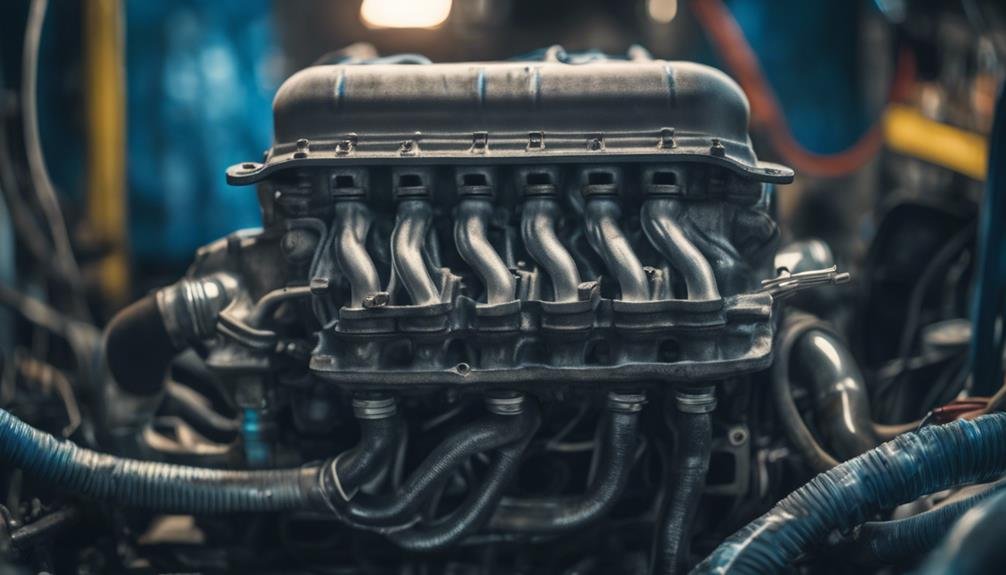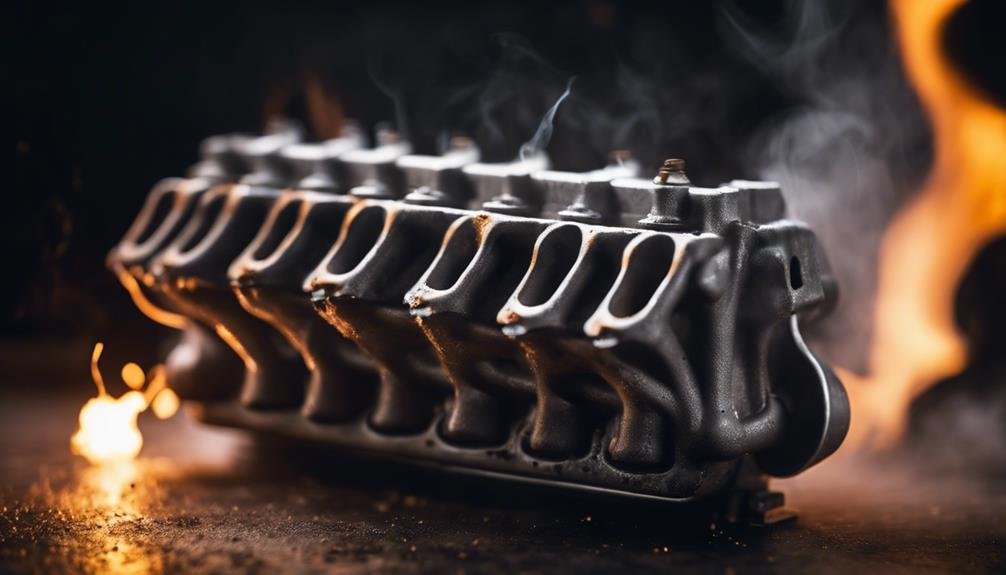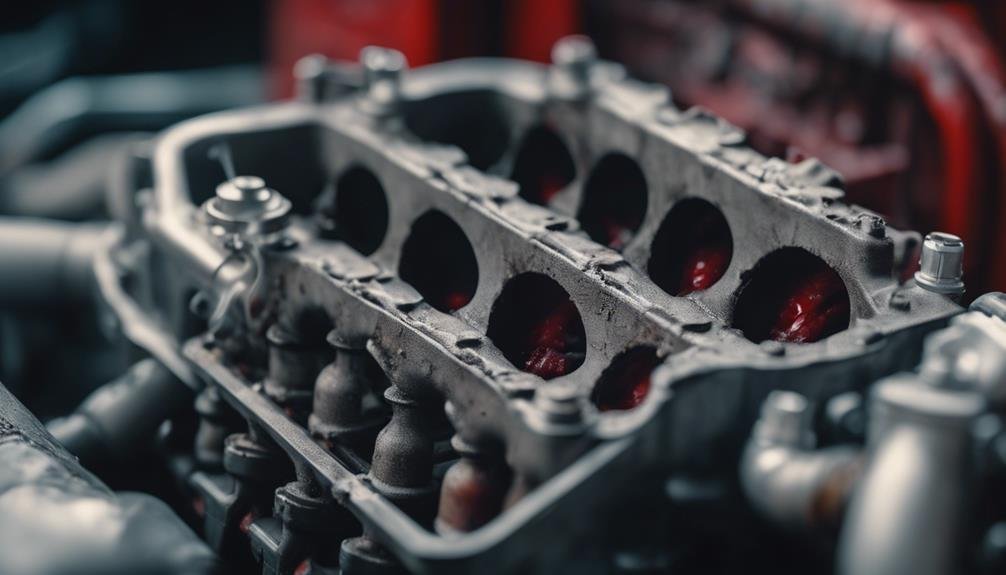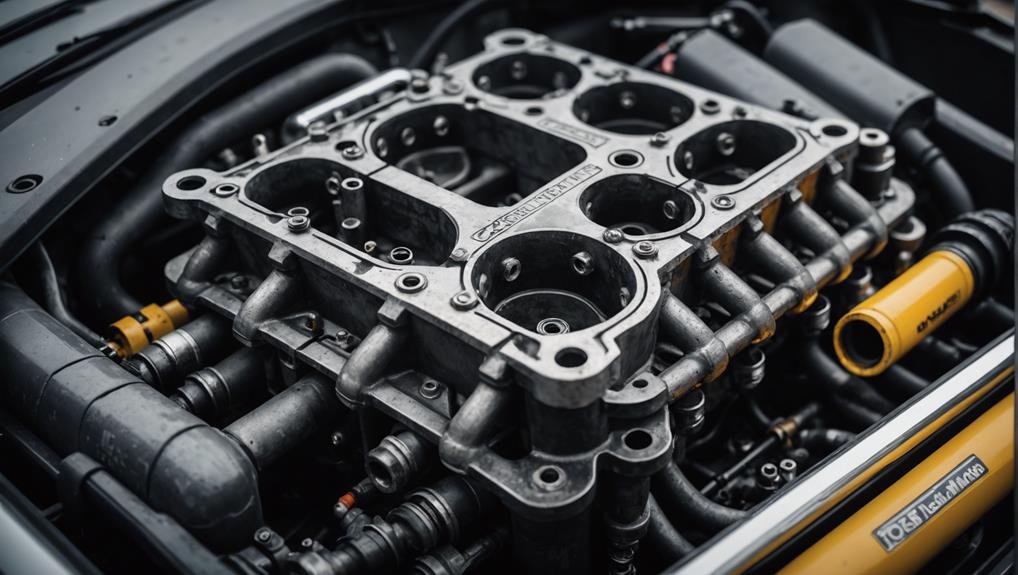When a cracked intake manifold starts to cause problems, you'll likely notice a combination of warning signs, including reduced engine performance, such as misfires and rough idling, and decreased acceleration. You may also hear unusual noises, like hissing or sucking sounds, and smell burning oil or antifreeze. Visible signs include coolant leaks, stains, or puddles under the car, and erratic engine performance. If you don't investigate these issues, you risk costly repairs or even complete engine failure. Keep an eye out for these symptoms, and delve further to understand the root causes and potential solutions.
Key Takeaways
- A cracked intake manifold can cause poor engine performance, including misfires, rough idling, and decreased acceleration.
- Coolant leaks can occur, leading to overheating and further engine damage if left unaddressed.
- Unusual engine noises, such as hissing or sucking sounds, may indicate a cracked intake manifold.
- Visible signs of coolant leakage, such as stains or puddles under the car, can indicate a cracked intake manifold.
- Decreased fuel efficiency and inconsistent engine performance are also common symptoms of a cracked intake manifold.
Engine Performance Warning Signs
As you put your vehicle through its paces, pay attention to reduced engine performance, including misfires, rough idling, and decreased acceleration, as these warning signs can indicate a cracked intake manifold.
When your engine isn't running smoothly, it may be a sign of a deeper issue. A cracked intake manifold can cause coolant leaks, which can lead to overheating and further engine damage.
Keep an eye out for poor fuel economy, as it can be a symptom of a cracked intake manifold affecting engine performance. Rough idling, in particular, can be a warning sign of an intake manifold leak.
Moreover, decreased acceleration can be a sign that your engine isn't functioning at its best. Be cautious of these warning signs, as they can indicate a cracked intake manifold.
Check Engine Light Illumination
If your check engine light illuminates on the dashboard, it may be a warning sign that your engine is experiencing a problem, possibly related to a cracked intake manifold. This illumination can serve as an early warning sign, indicating that something is amiss with your engine's air-fuel mixture, which may be compromised due to the cracked intake manifold.
As a result, you may notice rough idling or misfires, which can lead to further engine damage if left unchecked. Ignoring the check engine light can exacerbate the issue, causing more extensive damage to your engine.
Taking prompt action when the check engine light comes on is crucial, as it may be a sign of a cracked intake manifold. By addressing the issue promptly, you can prevent further engine damage and potentially costly repairs.
Unusual Engine Noises and Smells

When you're behind the wheel, unusual engine noises and smells can be a clear indication that something is amiss, and a cracked intake manifold might be the culprit. As you drive, you may notice hissing or sucking noises, which could be due to air leaks from a cracked intake manifold. Alternatively, you might catch a whiff of something unusual – a burnt plastic or sweet smell from coolant leaks, or the pungent aroma of burning oil or antifreeze.
Some common signs of a cracked intake manifold include:
- Engine backfires and popping noises, which can occur when the air-fuel mixture is disrupted
- Unusual engine smells, such as burning oil or antifreeze
- Air leaks and hissing noises from the intake manifold
- Coolant leaks, which can emit a sweet or burnt plastic smell
- Erratic engine performance, including misfires and stalling
Visible Leaks and Stains
Visible signs of coolant leakage can betray a cracked intake manifold, and it's vital to scrutinize the area for any telltale stains or puddles. When inspecting your vehicle, look for visible coolant leaks under the car, which may indicate a cracked intake manifold. Check for stains or puddles of coolant (green, red, or yellow) on the ground, as these can signal a leaking intake manifold. Moreover, inspect the engine block and intake manifold area for any signs of coolant stains, which can point to a crack in the intake manifold.
A cracked intake manifold can lead to coolant seeping out and leaving noticeable marks on the engine components. It's crucial to inspect the intake manifold area regularly to identify any potential cracks. Keep an eye out for signs of coolant seepage, such as green, red, or yellow stains, which can indicate a cracked intake manifold.
Misfires and Rough Idling

A cracked intake manifold can throw your engine's performance off-kilter, causing it to misfire and idle rough, which you'll likely notice when driving or standing still. You might feel the engine stumble or jerk when accelerating, or notice the engine vibrations when idling. These misfires can lead to reduced engine performance, resulting in sluggish acceleration and power loss.
Some common symptoms of misfires and rough idling include:
- Engine misfires, causing the engine to stumble or jerk during acceleration
- Rough idling, characterized by engine vibrations or shaking when stationary
- Sluggish acceleration due to reduced engine performance
- Power loss, making it difficult to merge or climb hills
- Inconsistent idle speed, fluctuating between high and low RPMs
If you're experiencing any of these symptoms, addressing the issue promptly is crucial to prevent further damage to your engine. Ignoring these signs can lead to more severe problems down the road.
Decreased Fuel Efficiency
As you continue to drive with a cracked intake manifold, you'll likely notice a decrease in fuel efficiency, which can be a significant concern for your wallet and the environment.
The crack in the intake manifold disrupts the proper distribution of fuel, resulting in improper air-to-fuel ratios, which, in turn, lead to decreased fuel efficiency. This means your vehicle will consume more fuel than usual, increasing your fuel costs and carbon footprint.
Moreover, engine misfires caused by the crack can lead to inefficient combustion, further decreasing fuel economy. Monitoring your fuel consumption and addressing any changes promptly can help detect a cracked intake manifold early.
Keep in mind that reduced fuel efficiency is a common symptom of a cracked intake manifold, impacting vehicle performance. By recognizing this symptom, you can take proactive steps to address the issue before it leads to more severe problems.
Overheating Engine Symptoms

Since coolant flows through the intake manifold, a crack can cause leaks, leading to overheating engine symptoms that you should be aware of. As a result, you may notice steam coming from the hood, and your temperature gauge rising. These are clear signs that your engine is overheating, which can cause significant damage if left unchecked.
Some common overheating engine symptoms to watch out for include:
- Rising temperature gauge
- Steam from the hood
- Coolant leaks
- Engine damage due to overheating
- Increased risk of costly repairs or engine failure
Regular inspection and maintenance can help detect and prevent issues with a cracked intake manifold. By catching these problems early, you can avoid costly repairs and potential engine failure.
Don't wait until it's too late – keep an eye out for these overheating engine symptoms and address any issues promptly to ensure the longevity of your engine.
Poor Acceleration Performance
You may notice your vehicle struggling to accelerate smoothly, which can be a frustrating experience, especially during heavy traffic or uphill climbs.
This poor acceleration performance could be a symptom of a cracked intake manifold, which can lead to air leaks that disrupt the engine's ability to generate power efficiently.
The crack in the intake manifold can affect the air-fuel ratio, resulting in hesitation, sluggishness, and reduced throttle response during acceleration.
As a result, engine power output may be compromised, leading to slower response times, reduced speed, and a lack of smooth acceleration.
The combustion process is also affected, further contributing to acceleration issues.
It's crucial to diagnose and repair the cracked intake manifold promptly to restore efficient engine function and acceleration capabilities.
By addressing the root cause of the problem, you can regain the performance and responsiveness you expect from your vehicle.
Don't let a cracked intake manifold hold you back – get back on the road with confidence and power.
Frequently Asked Questions
How Do I Know if My Intake Manifold Is Cracked?
You're wondering if your intake manifold is cracked? Start by visually inspecting it for cracks or damage, then check for coolant leaks, hissing sounds, or overheating issues – if you're still unsure, have a pro perform a pressure test.
What Does a Cracked Intake Manifold Sound Like?
You might hear a hissing or sucking sound coming from your engine bay or intake manifold area, varying in intensity, indicating a possible cracked intake manifold, which you should investigate promptly to prevent further damage.
Can I Drive My Car With a Cracked Intake Manifold?
You shouldn't drive your car with a cracked intake manifold, as it can lead to decreased performance, overheating, and further damage. It's recommended to address the issue immediately to prevent more costly repairs down the road.
What Are the Symptoms of a Cracked Manifold?
You're wondering what symptoms to look out for, and rightfully so! If your car's misfiring, idling rough, or overheating, it might be a cracked intake manifold, which can also cause coolant leaks, unusual smells, poor fuel efficiency, and decreased performance.
Conclusion
Now that you've identified the symptoms of a cracked intake manifold, it's crucial to address the issue promptly.
Failing to do so can lead to further engine damage, decreased performance, and even complete engine failure.
By recognizing the warning signs, such as engine misfires, rough idling, and decreased fuel efficiency, you can take proactive steps to repair or replace the intake manifold, restoring your engine's performance and preventing more costly repairs down the road.
